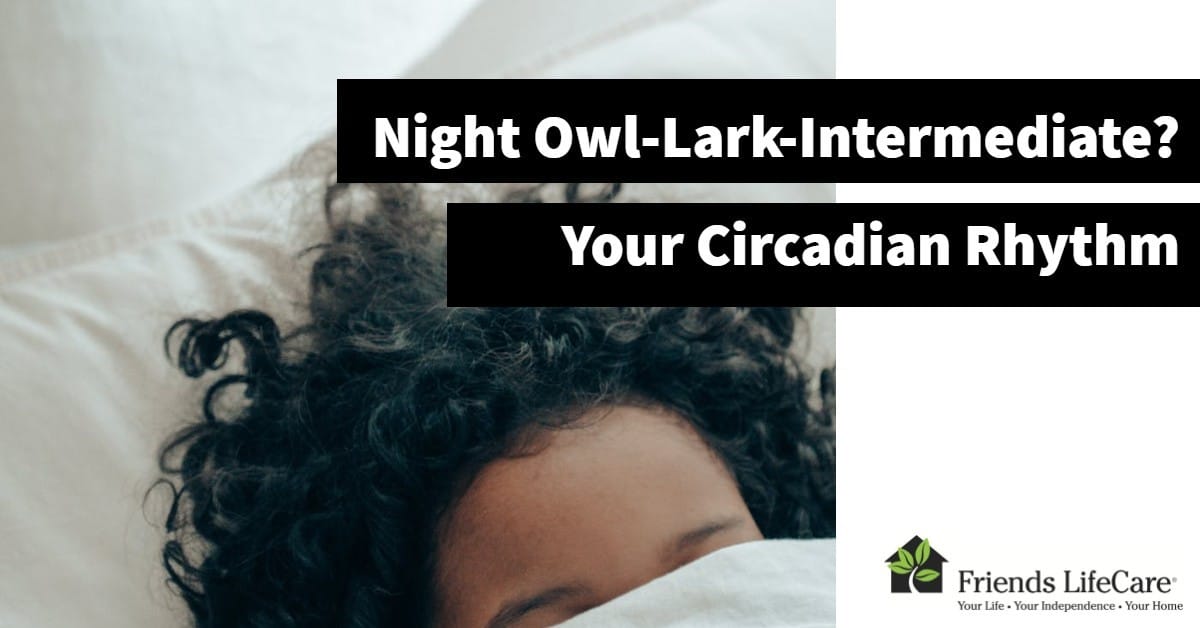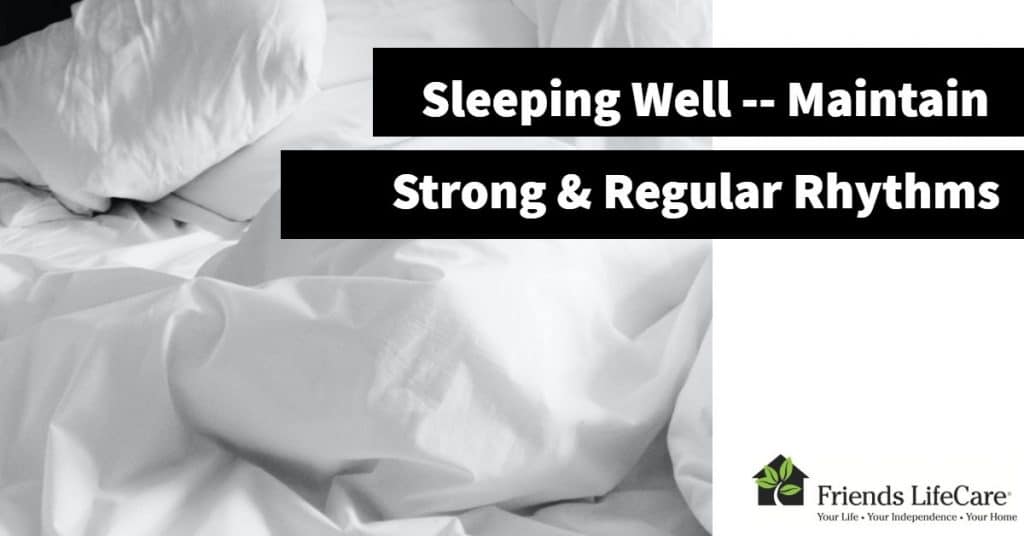Sleep: Understanding your Body Clock

There are a number of biological processes in our body involved in regulating our sleep. One of the most important components of this system is our internal body clock. There is a part of the brain called the suprachiasmatic nucleus (SCN for short) that serves as a “master clock”. The SCN keeps our body on a regular, 24-hour rhythm.
Almost everything in the body follows a 24-hour rhythm.
- Body temperature follows a daily rhythm. Our coolest point occurs early in the morning. And our temperature peaks in the early part of the night.
- Many hormones in our body cycle with a daily rhythm. One of these — melatonin — is an important regulator of our rhythms.
- Weight follows a daily rhythm. If you weigh yourself on a regular basis, make sure you do it at a consistent time of day. Otherwise you may see fluctuations of a few pounds heavier or lighter just based on what time it is.
- Height – Even our height follows a rhythm. You are tallest when you first wake up in the morning. When you sit and stand all day the force of gravity slightly compresses your bones; and you shrink. Then when you lie flat in bed at night your bones stretch out again. It’s a microscopic difference so you won’t notice getting shorter as the day goes on.
Rhythms are features of many aspects of our biological functioning.
We call these rhythms circadian rhythms, which comes from the Latin words circa = about and dies = a day. So these are rhythms are about a day long. We have other rhythms that are shorter than 24-hours, such as our 90-minute sleep cycles, and other rhythms that are longer such as the menstrual cycle and seasonal rhythms. But in this article, we are going to focus on circadian rhythms.

Are circadian rhythms the same in everyone?
We all have circadian rhythms, but the timing of rhythms varies from person to person. This is captured well by what is called our chronotype. Chronotype is a term used to describe our general circadian tendencies.
3 types of chronotypes.
 The first type are referred to as night owls, or evening types. Night owls have circadian rhythms that are later than in other people. This means that they are often awake until later at night and may even get a second wind when other people are going to bed. In the morning, it is often difficult for them to wake up early. And they tend to sleep in late when they have the opportunity.
The first type are referred to as night owls, or evening types. Night owls have circadian rhythms that are later than in other people. This means that they are often awake until later at night and may even get a second wind when other people are going to bed. In the morning, it is often difficult for them to wake up early. And they tend to sleep in late when they have the opportunity.
At the other end of the spectrum are larks, or morning types, who have  circadian rhythms that are earlier compared to other people. They often feel sleepy early at night and may end up dozing off while engaged in sedentary activities in the evening. They then wake up early in the morning — sometimes even before the sun is up — and are not able to get back to sleep.
circadian rhythms that are earlier compared to other people. They often feel sleepy early at night and may end up dozing off while engaged in sedentary activities in the evening. They then wake up early in the morning — sometimes even before the sun is up — and are not able to get back to sleep.
The third group is what are called intermediate types. They are neither night owls nor larks, but somewhere in the middle.
Which chronotype do you think you are? Are you an owl? A lark? Or in the middle as an intermediate type?
Can my chronotype change?
In thinking about your own chronotype, you may be thinking that it has changed over your life. If so, you are not alone. Most people experience changes in their chronotype at particular periods in their life.
The most pronounced change in chronotype occurs in our teenage years. Starting at puberty,  there is a gradual shift in our circadian rhythms to later timing. In fact, the average shift is 2-3 hours later! When you were a teenager, you may have tended to stay up late at night and wanted to sleep in later in the morning or even into the early afternoon. Teenagers are often seen as being lazy or rebellious because of these patterns; but it’s primarily due to a change in their circadian biology.
there is a gradual shift in our circadian rhythms to later timing. In fact, the average shift is 2-3 hours later! When you were a teenager, you may have tended to stay up late at night and wanted to sleep in later in the morning or even into the early afternoon. Teenagers are often seen as being lazy or rebellious because of these patterns; but it’s primarily due to a change in their circadian biology.
This is the reason that more and more school districts are shifting school start times for high schoolers later. Right now, teenage students often have to be at school and paying attention at a time of morning when their brain is still partially asleep. Research has shown that delaying school start time can improve attendance and grades in morning classes.
For most people, their circadian rhythms will gradually shift back to an earlier schedule in the  early to mid twenties. However, some people will remain night owls their whole life. For much of our adult years, chronotype tends to be fairly stable. As we get older, some people gradually become more of a lark because of circadian rhythms shifting earlier. Some older adults find that they are not able to stay awake as long as they used to, and they wake up earlier in the morning than they did when they were younger. These are normal changes that can happen with age.
early to mid twenties. However, some people will remain night owls their whole life. For much of our adult years, chronotype tends to be fairly stable. As we get older, some people gradually become more of a lark because of circadian rhythms shifting earlier. Some older adults find that they are not able to stay awake as long as they used to, and they wake up earlier in the morning than they did when they were younger. These are normal changes that can happen with age.
Another factor that change circadian rhythms is shift work. Almost 25% of the U.S. workforce follows some type of shift work schedule including overnight shifts. Shift work can be very difficult on our circadian rhythms, because we are trying to work at a time that our body thinks we should be sleeping. Many people can adjust their circadian rhythms to shift work schedules, but it is often common to have a hard time with it.
When people stop doing shift work, their circadian rhythms often return to a more typical schedule. But for other people, their rhythms seem to get “stuck”. For example, some people who worked night shift in the past feel that their body is still on a night schedule, even though they have not worked nights for years. We don’t yet understand why this happens, but it is one way that our circadian rhythms can change over time.
How do circadian rhythms affect my sleep?
Whatever your chronotype, you will tend to sleep best when your sleep schedule is in sync with your circadian rhythm. If your sleep schedule is out of sync with your circadian rhythms, you are more likely to have trouble sleeping.

This occurs frequently for night owls, who may not want to follow a late bedtime and wake-up time because of a conflicting work schedule, family commitments, or just for personal preference.
Night owls often get into bed at a more typical bedtime, but then they are not able to fall asleep because their circadian rhythm is still in “awake mode”. They eventually fall asleep, but then when they try to wake up in the morning it’s difficult because their body is still in “sleep mode”. They may sleep through alarms or have to set multiple alarms in order to wake up at their desired time. Night owls will often say that when they wake up early in the morning they don’t feel fully awake and alert for several hours.
Larks can experience the opposite pattern. As described above, they often feel tired and may doze off in the evening, and it can be difficult to stay awake until their desired bedtime. Once they go to bed they often fall asleep very quickly. But then they wake up early in the morning and are not able to get back to sleep.
The key is that being a lark or an owl is only a problem IF that circadian tendency conflicts with  the schedule you want or need to keep. There’s nothing inherently bad or unhealthy about being a night owl or a lark. For many years our society has tended to favor waking up early in the morning and frowned upon being a night owl.
the schedule you want or need to keep. There’s nothing inherently bad or unhealthy about being a night owl or a lark. For many years our society has tended to favor waking up early in the morning and frowned upon being a night owl.
Benjamin Franklin captured this well with his famous saying of “Early to bed and early to rise, makes a man healthy, wealthy, and wise”. Despite this cultural bias, night owls can live very healthy, productive lives just as much as larks. It’s just a matter of whether they have the flexibility to follow a sleep schedule that matches those night owl tendencies.
How to strengthen your circadian rhythms.
Stronger circadian rhythms can help to promote better sleep and overall health. With all this in mind, you may be wondering what you can do to strengthen your circadian rhythms. Fortunately, there are some fairly basic steps you can take to enhance your ‘circadian health.’
1) Follow a regular sleep schedule.
Select a bedtime and wake-up time that you can follow on a consistent basis. This may seem really basic, but it can be more challenging than it may seem at first glance because it means following the same schedule 7 days per week. Many people follow a pattern of keeping a consistent schedule during the work week, but then sleep in later and going to bed later on the weekends. This has the advantage of providing an opportunity to catch up on sleep. The disadvantage is that this can weaken circadian rhythms.
More consistency = stronger circadian rhythms.
Our rhythms start to get on a regular pattern by the end of the work week but then have to adjust on the weekends and readjust the following Monday morning. For some people, the weekend shift can be by several hours compared to their weekday schedule. This pattern is actually referred to as social jetlag because it has a similar impact on your body to flying across multiple time zones for the weekend, and then flying back the next week. So pick a bedtime and wake-up time that you can follow consistently for as many days of the week as possible.
2) Take control of your exposure to bright light.
Bright light is actually the strongest cue in our environment for regulating our circadian rhythms. Getting at least 30-60 minutes of bright light exposure at some point in the day is good for our body clock. Sunlight is by far the best, but even bright room lighting is helpful. 
There’s one exception to this, which is that you want to start minimizing light exposure about an hour before your planned bedtime. Bright light close to bedtime can actually shift your circadian rhythms to a later schedule, making you more of a night owl. This does not mean that you should sit in a dark room at night, but just avoid really bright lighting as it gets closer to bedtime.
In particular, you want to avoid the bright light that comes from electronics such as mobile phones, computers, or e-readers. These types of screens give off a lot of blue light, which has the biggest impact on circadian rhythms. Plus we often use these devices close to our face, maximizing the amount of blue light that gets into our eyes.
So try to avoid using electronics close to the face for 1-2 hours before bedtime. If you need to be on these devices, there are often settings or software you can download that allow you to filter out blue light at specified times.
3) Have regularity in your day.
Eating meals at around the same time of day is helpful. If you exercise, try to do that at a regular time of day. Maintaining regular activities does not have as strong of an effect as the strategies above, but it can help.

Hopefully this helps you understand your body’s internal clock and the way it keeps us operating on a daily, circadian rhythm. Having strong, regular rhythms is important for sleeping well and for overall health and well being.
Contributed by:

Photo sources:
but first coffee: https://www.twenty20.com/photos/df9c06e5-89eb-4e43-81a0-57faa428eed8/?utm_t20_channel=bl
benjamin franklin: https://www.twenty20.com/photos/d14dbb8e-f35f-45f0-bfec-ae505e0195f9/?utm_t20_channel=bl
owl: https://www.twenty20.com/photos/267aff21-ab07-44af-a68b-0715e5ff2124/?utm_t20_channel=bl
sleeping student: https://www.twenty20.com/photos/9b374883-b917-454f-8a0d-2d8d000bec8a/?utm_t20_channel=bl
sleeping man: https://www.twenty20.com/photos/afb5e8fa-561b-417a-80c3-8107afbaac06/?utm_t20_channel=bl
